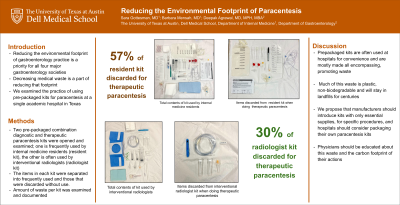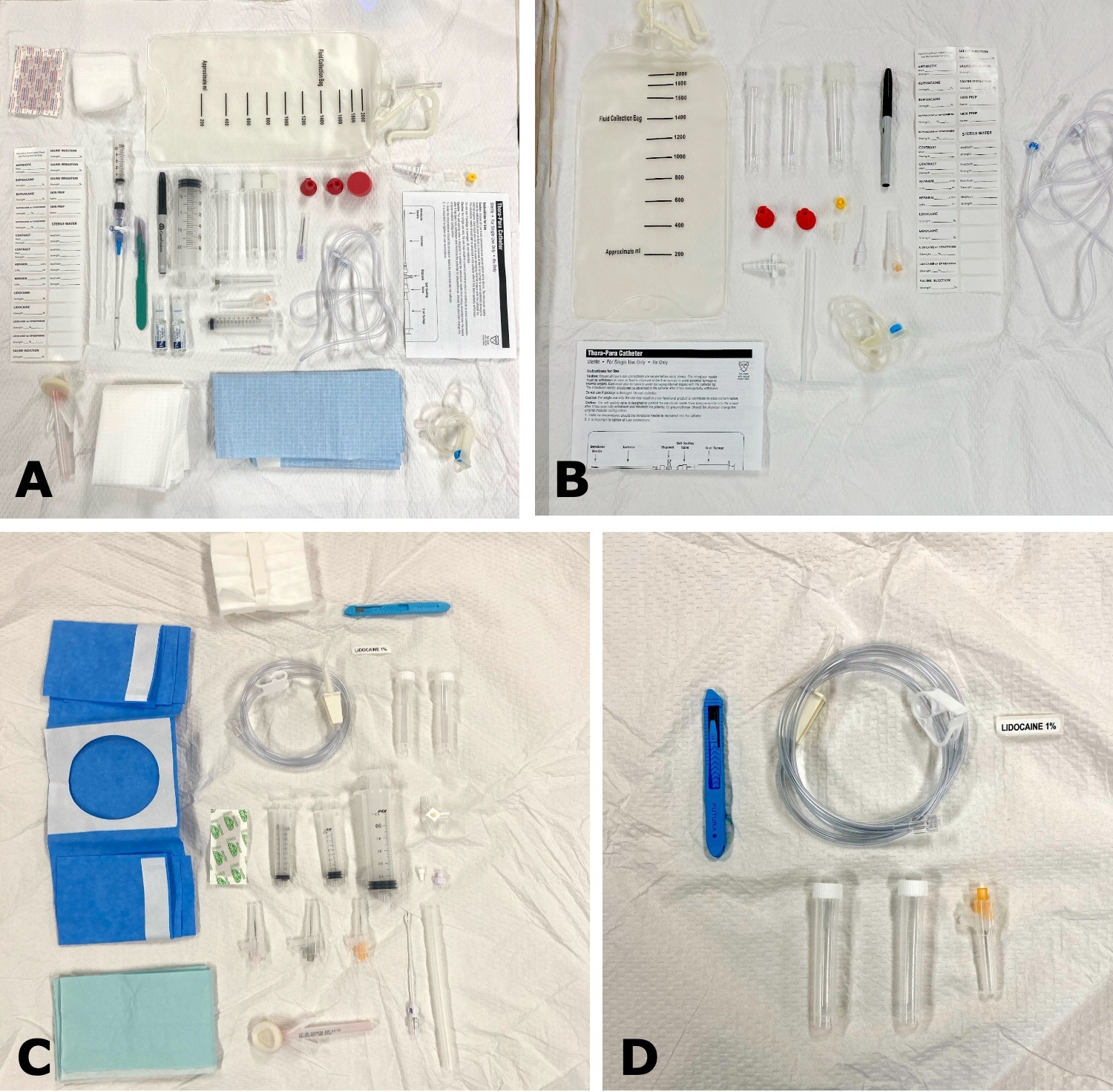Tuesday Poster Session
Category: Practice Management
P4051 - Reducing the Environmental Footprint of Paracentesis
Tuesday, October 24, 2023
10:30 AM - 4:00 PM PT
Location: Exhibit Hall

Has Audio

Sara Gottesman, MD
Dell Medical School at The University of Texas at Austin
Austin, TX
Presenting Author(s)
Sara Gottesman, MD1, Barbara Mensah, MD1, Deepak Agrawal, MD, MBA, MPH2
1Dell Medical School at The University of Texas at Austin, Austin, TX; 2Dell Medical School, Austin, TX
Introduction: Reducing the environmental footprint of gastroenterology practice was recently declared as a priority by the four major gastroenterology societies. There is a call and a need to reexamine all practices and propose ideas to decrease medical waste. We examined the practice of using pre-packaged kits for paracentesis at a single academic hospital in Texas, since we noticed that many of the items were discarded without being used.
Methods: Two pre-packaged paracentesis kits were opened and examined. One kit was frequently used by internal medicine residents, the other was used by interventional radiologists. These kits were used for both diagnostic and therapeutic paracentesis. The items in each kit were separated into those that were frequently used and those that were discarded without use.
Results: The kit primarily used by internal medicine residents (kit 1) was intended for both paracentesis and thoracentesis. Figure A displays all contents of kit 1; figure B displays the items that were routinely discarded prior to therapeutic paracentesis. For therapeutic paracentesis, 17 of the 30 items in the kit were unused (57%). For diagnostic paracentesis, 21 (70%) were unused and discarded.
Kit 2, shown in figure C, was used by the interventional radiologists. It had fewer items disposed of prior to use (figure D), with only 6 out of 20 items (30%) discarded for therapeutic paracentesis. Information about items discarded when performing diagnostic paracentesis was not available. Both kits required additional supplies to attach the abdominal catheter to wall suction for therapeutic paracentesis, culture bottles for specimen collection for diagnostic paracentesis, and various additional items depending on the preference of individual performing physicians.
Discussion: Prepackaged kits are often used at hospitals for convenience and are often made all encompassing, which promotes waste. Notably, the same kit is used for both diagnostic and therapeutic paracentesis, even though diagnostic paracentesis needs fewer supplies. Much of this waste is plastic, non-biodegradable and will stay in landfills for centuries. We propose that manufacturers should introduce kits with only essential supplies and hospitals should consider packaging their own paracentesis kits. Physicians should be educated about this waste and the carbon footprint of their actions.

Disclosures:
Sara Gottesman, MD1, Barbara Mensah, MD1, Deepak Agrawal, MD, MBA, MPH2. P4051 - Reducing the Environmental Footprint of Paracentesis, ACG 2023 Annual Scientific Meeting Abstracts. Vancouver, BC, Canada: American College of Gastroenterology.
1Dell Medical School at The University of Texas at Austin, Austin, TX; 2Dell Medical School, Austin, TX
Introduction: Reducing the environmental footprint of gastroenterology practice was recently declared as a priority by the four major gastroenterology societies. There is a call and a need to reexamine all practices and propose ideas to decrease medical waste. We examined the practice of using pre-packaged kits for paracentesis at a single academic hospital in Texas, since we noticed that many of the items were discarded without being used.
Methods: Two pre-packaged paracentesis kits were opened and examined. One kit was frequently used by internal medicine residents, the other was used by interventional radiologists. These kits were used for both diagnostic and therapeutic paracentesis. The items in each kit were separated into those that were frequently used and those that were discarded without use.
Results: The kit primarily used by internal medicine residents (kit 1) was intended for both paracentesis and thoracentesis. Figure A displays all contents of kit 1; figure B displays the items that were routinely discarded prior to therapeutic paracentesis. For therapeutic paracentesis, 17 of the 30 items in the kit were unused (57%). For diagnostic paracentesis, 21 (70%) were unused and discarded.
Kit 2, shown in figure C, was used by the interventional radiologists. It had fewer items disposed of prior to use (figure D), with only 6 out of 20 items (30%) discarded for therapeutic paracentesis. Information about items discarded when performing diagnostic paracentesis was not available. Both kits required additional supplies to attach the abdominal catheter to wall suction for therapeutic paracentesis, culture bottles for specimen collection for diagnostic paracentesis, and various additional items depending on the preference of individual performing physicians.
Discussion: Prepackaged kits are often used at hospitals for convenience and are often made all encompassing, which promotes waste. Notably, the same kit is used for both diagnostic and therapeutic paracentesis, even though diagnostic paracentesis needs fewer supplies. Much of this waste is plastic, non-biodegradable and will stay in landfills for centuries. We propose that manufacturers should introduce kits with only essential supplies and hospitals should consider packaging their own paracentesis kits. Physicians should be educated about this waste and the carbon footprint of their actions.

Figure: Figure A: Full contents of Kit 1
Figure B: Items discarded from Kit 1 for a therapeutic paracentesis
Figure C: Full contents of Kit 2
Figure D: Items discarded from Kit 2 for a therapeutic paracentesis
Figure B: Items discarded from Kit 1 for a therapeutic paracentesis
Figure C: Full contents of Kit 2
Figure D: Items discarded from Kit 2 for a therapeutic paracentesis
Disclosures:
Sara Gottesman indicated no relevant financial relationships.
Barbara Mensah indicated no relevant financial relationships.
Deepak Agrawal indicated no relevant financial relationships.
Sara Gottesman, MD1, Barbara Mensah, MD1, Deepak Agrawal, MD, MBA, MPH2. P4051 - Reducing the Environmental Footprint of Paracentesis, ACG 2023 Annual Scientific Meeting Abstracts. Vancouver, BC, Canada: American College of Gastroenterology.
